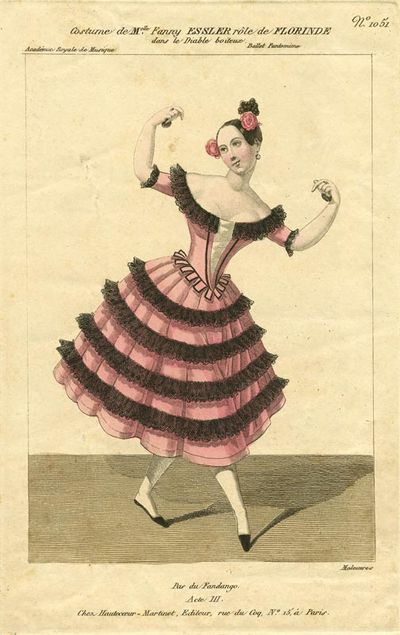Annotation:Fanny Elssler's Hornpipe: Difference between revisions
No edit summary |
No edit summary |
||
| Line 10: | Line 10: | ||
<div style="text-align: justify; direction: ltr; margin-bottom: 90px; margin-left: 70px; margin-right: 120px;"> | <div style="text-align: justify; direction: ltr; margin-bottom: 90px; margin-left: 70px; margin-right: 120px;"> | ||
<br> | <br> | ||
'''FANNY ELSSLER'S HORNPIPE.''' American, Hornpipe (2/4 time). F Major. Standard tuning (fiddle). AABB. Austrian dancer Fanny Elssler [https://en.wikipedia.org/wiki/Fanny_Elssler] (1810-1884) left the Paris Opera between 1840 and 1842 to tour the United States, performing in Boston, Philadelphia, New York, New Orleans, St. Louis as well as Havana. The theatrical news weekly '''The Spirit of the Times''' wrote that watching Elssler dance "was something to increase our enjoyment of life on the stage, to elevate and idealize the beauty of girlhood, the movements of the form in happy natural woman, by marrying them to music and dance." | [[File:ellsler.jpg|400px|thumb|right|Fanny Ellsler as Florinda in the dance La Cachucha from the 1836 Coralli/Gide ballet Le Diable boiteux. Paris, 1836]] | ||
'''FANNY ELSSLER'S HORNPIPE.''' American, Hornpipe (2/4 time). F Major. Standard tuning (fiddle). AABB. Austrian dancer Fanny Elssler [https://en.wikipedia.org/wiki/Fanny_Elssler] (1810-1884) left the Paris Opera between 1840 and 1842 to tour the United States, performing in Boston, Philadelphia, New York, New Orleans, St. Louis as well as Havana. The theatrical news weekly '''The Spirit of the Times''' wrote that watching Elssler dance "was something to increase our enjoyment of life on the stage, to elevate and idealize the beauty of girlhood, the movements of the form in happy natural woman, by marrying them to music and dance." | |||
<br> | <br> | ||
</div> | </div> | ||
Revision as of 13:24, 12 August 2017
X:1 % T:Fanny Elssler's Hornpipe M:2/4 L:1/8 B:Oliver Ditson – The Boston Collection of Instrumental Music (c. 1850, p. 59) Z:AK/Fiddler’s Companion K:F f/g/|a/g/f/e/ g/f/e/d/|c/d/c/=B/ c/d/e/f/|c/d/c/=B/ c/d/e/f/|g/a/^f/a/ g=f/g/| a/g/f/e/ g/f/e/d/|c/d/c/=B/ c/d/e/f/|d/e/f/g/ e/f/g/a/|f/c/a/g/ f!fermata!:| f/g/|(a/f/).f/.f/ (g/e/).e/.e/|(f/d/).d/.d/ (e/^c/).c/.c/|d/A/g/e/ d/e/f/d/|e/A/a/A/ ef/g/| (a/f/).f/.f/ (g/e/).e/.e/|(f/d/).d/.d/ (e/^c/).c/.c/|d/A/d/f/ a/g/e/f/|d/A/f/e/ d!D.C.!:|]

FANNY ELSSLER'S HORNPIPE. American, Hornpipe (2/4 time). F Major. Standard tuning (fiddle). AABB. Austrian dancer Fanny Elssler [1] (1810-1884) left the Paris Opera between 1840 and 1842 to tour the United States, performing in Boston, Philadelphia, New York, New Orleans, St. Louis as well as Havana. The theatrical news weekly The Spirit of the Times wrote that watching Elssler dance "was something to increase our enjoyment of life on the stage, to elevate and idealize the beauty of girlhood, the movements of the form in happy natural woman, by marrying them to music and dance."
